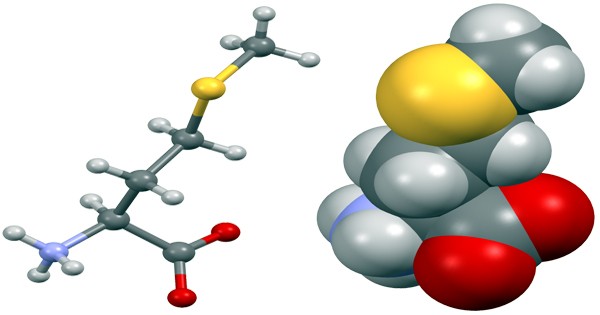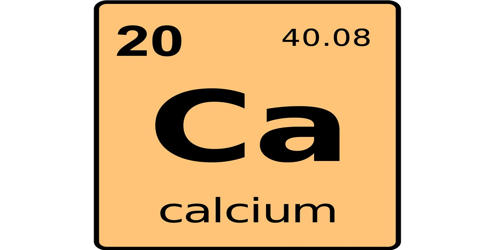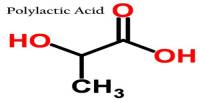Methionine (symbol Met or M) (/mɪˈθaɪəniːn/) is one of nine essential amino acids in humans (provided by food), and it is required for growth and tissue repair. Methionine plays a vital role in the metabolism and wellbeing of many animals, including humans, as the substrate for other amino acids, such as cysteine and taurine, versatile compounds such as SAM-e, and the essential antioxidant glutathione. It is an intermediate in transmethylation reactions, acting as the primary methyl group donor, in addition to being a substrate for protein synthesis. Since it is incapable of being biosynthesized in the body, it must be obtained from diet and food sources. A major part of angiogenesis, the formation of new blood vessels, is also methionine. Those suffering from copper poisoning can benefit from supplementation.
Methionine accounts for around 5 percent of the weight of egg albumin, first isolated from casein (1922); other proteins contain much smaller quantities of methionine. For mammals and fowl, it is one of the so-called essential amino acids; that is, they do not synthesize it. In microorganisms, cysteine and aspartic acid are synthesized from amino acids. Methionine, a sulphur-containing amino acid, enhances the tone and bending of the skin, hair, and strengthens nails. Sulphur supplied by methionine, involved in many detoxifying processes, protects cells from toxins, inhibits cell aging, and is important for the absorption and bio-availability of selenium and zinc.

Ball-and-stick model; Space-filling model of Methionine
In a number of studies, overconsumption of methionine, the methyl group donor in DNA methylation, is linked to cancer development. Methylthiobutanenitrile acid is the scientific name for L-methionine and is one of the essential amino acids. It is a flaky white crystal or crystalline powder with a particular odor. It comprises an alpha-amino group (which under biological conditions is in the protonated-NH3+ form), a carboxyl group (which under biological conditions is in the deprotonated-COO-form), and an S-methyl thioether side chain, classifying it as a nonpolar, aliphatic amino acid.
It plays a role as a nutraceutical, a micronutrient, a paracetamol poisoning antidote, a human metabolite, and a metabolite for the rodent. It is an amino acid of the aspartate, proteinogenic amino acid, methionine, and L-alpha-amino acid family. Its molecular relative weight is 149.21. DL-methionine(racemic)m.p. 281℃(decomposition). Its relative density amounts to 1.340. It is soluble in water, dilute acid and dilute alkaline solution, and is slightly soluble in ethanol at 95%, which is insoluble in ether. 280 ~ 281°C L-methionine (L-body) melting point (decomposition). Methionine is coded for by the starting codon in the nuclear genes of eukaryotes and in Archaea, meaning it indicates the beginning of the coding region and is the first amino acid formed during mRNA translation in a nascent polypeptide.
Methionine, which is insoluble in ethanol, ethyl ether, petroleum ether, benzene, and acetone, is soluble in hot water and alcohol. Melting point 273°C D-methionine (D-body) (decomposition). It is soluble in water, acid, and alkaline, and only slightly soluble in alcohol and insoluble in ether. Along with cysteine, one of two proteinogenic amino acids containing sulfur is methionine. As a result, methionine is frequently incorporated during translation into the N-terminal position of proteins in eukaryotes and archaea, while post-translational modification may eliminate it. As the initial amino acid, the derivative N-formylmethionine is used in bacteria.
L-Methionine is primarily used as a dietary feed supplement and is one of the important animal growth amino acids, the “skeleton” amino acid in protein biosynthesis, and the primary methyl donor in the animal body. In plants and microorganisms, along with threonine and lysine (via diaminopimelate, but not via alpha-aminoadipate), methionine biosynthesis belongs to the aspartate class. The key backbone is derived from aspartic acid, while cysteine, methanethiol, or hydrogen sulfide can provide the sulfur. In the process of synthesis of choline by adrenal hormone and fatty liver phospholipids during the in vivo animal metabolism process, L-Methionineplays a certain position. Lack of L-Methioninein in livestock and poultry will result in poor development, weight loss, decreased liver and kidney function, atrophy of muscles, degradation of fur, etc.
Nausea, vomiting, drowsiness, and irritability can be caused by methionine. In patients with acidosis, it should not be used. In patients with proven liver damage, it can aggravate hepatic encephalopathy; it should be used with caution in patients with serious liver disease. Methionine loss has been associated with senile hair greying. The absence of this leads to an accumulation of hydrogen peroxide in hair follicles, a decline in the efficacy of tyrosinase, and a progressive loss of hair color. It is therefore beneficial for schizophrenia treatment. The need for L-Methionine also increases if the body’s toxic substances rise.
Methionine may also be required to reverse damaging glucocorticoid receptor methylation caused by repeated exposures to stress, with consequences for depression. It is used for fatty liver and cirrhosis. Widely used as feed additives to increase the quality of feed, improve the use of native protein and encourage the growth of animals. In the biosynthesis of cysteine, carnitine, taurine, lecithin, phosphatidylcholine, and other phospholipids, methionine is intermediate. Improper methionine conversion may lead to atherosclerosis due to homocysteine accumulation. It has been used as a pH control agent in parenteral formulations, and it has also been used experimentally with antibodies as an antioxidant. Methionine in oral tablets is also used therapeutically.
Information Sources:
















